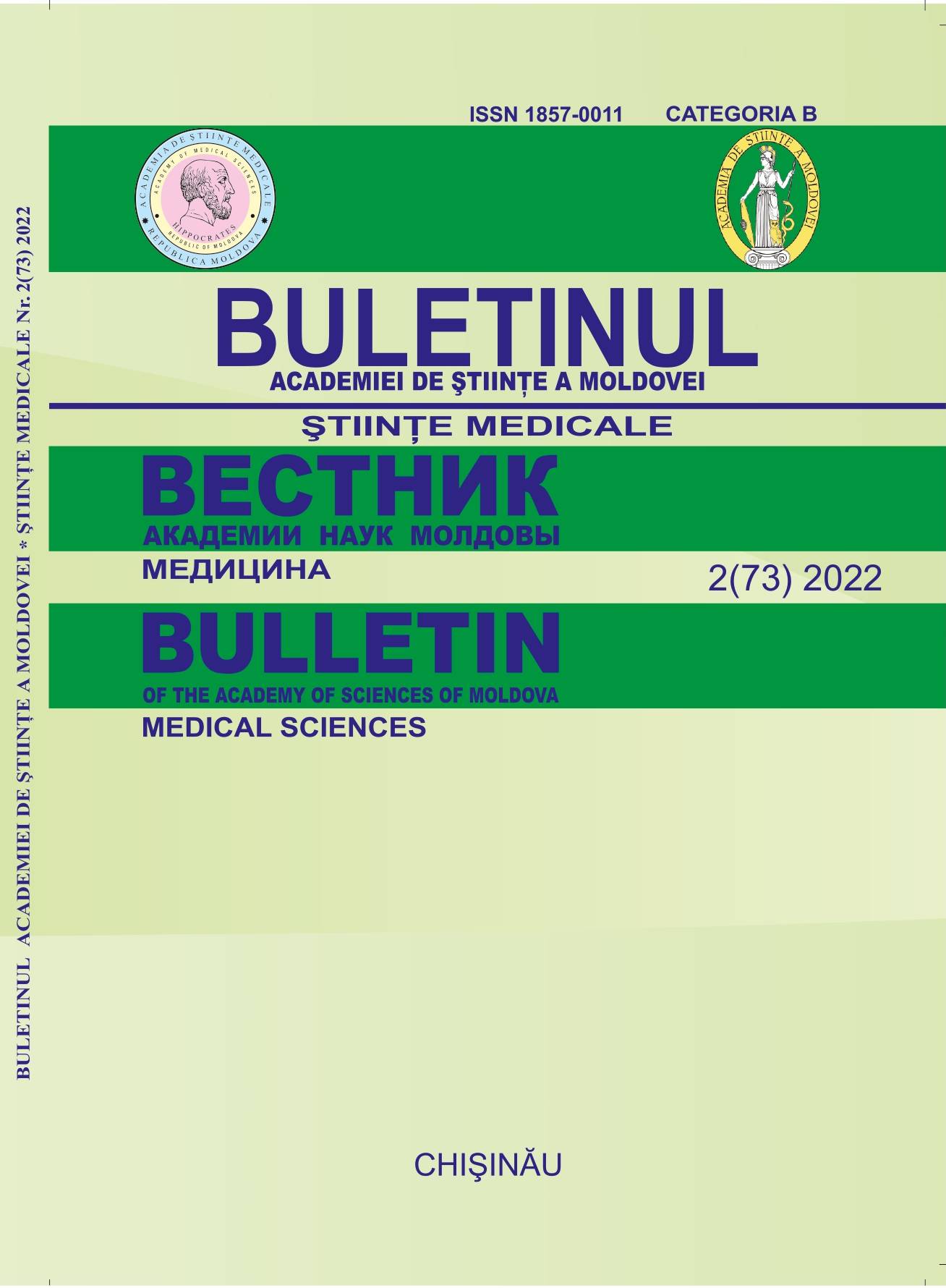Personalized immunohistochemical particulars of thyroid cancer in children
DOI:
https://doi.org/10.52692/1857-0011.2022.2-73.08Keywords:
thyroid cancer, children, papillary cancer, follicular cancer, medullary cancerAbstract
The idea of the paper from the state scientific program under the name „Modern personalized surgery in the diagnosis and complex treatment of tumors in children”. In the first stage, the executors conducted statistical research on the incidence of thyroid cancer in children. During 40 years from 18549 cases of nodular thyroid pathology, 1078 cases were detected at children: 105 - (9.7%) with cancer, adenomas 534 (49.5%), toxic nodular goiter 213 (19.7%) , struma Hashimoto 226 (21%),: ratio girl : boys 6: 1. The most affected age is 9-16 years. The highest morbidity is in children aged from 12 to 15 years.The morphological structure of thyroid cancer in children (105 patients) was as follows: first - papillary cancer - 68.6%, the second follicular cancer 23.8%, the third medullary cancer - 5.7% and the fourth anaplastic cancer - 1.9%.The priority goal of the authors was personalized medicine, which involves selecting an appropriate treatment for the patient, depending on the volume of the primary tumor, the morphological type and the biological evolution of the tumor. In the diagnostic plan for the assessment of tumor aggression, the authors will propose immunohistochemical research in assessing the angioinvasive aggression of thyroid carcinomas in children. It is proposed to investigate the expression of thyroiglobulin, keratin and vimentin, peroxidase. Peroxidase expression was studied in 22 children. Thyroglobulin expression was studied in 31 children. And the expression of keratin and vimentin was studied in 16 children [2, 4-6].
References
Varodi Viorica. „Studii comparative ale metodelor imagistice în stadializarea cancerului de col uterin”, Universitatea de Medicină și Farmacie „Iuliu Hațieganu” Cluj-Napoca, 2010, pag. 206
Ţîbîrnă A. Aspecte epidemiologice ale morbidităţii prin adenom, tiroidită autoimună şi cancer tiroidian în Republica Moldova. Buletinul Academiei de Ştiinţe a Moldovei, ştiinţe medicale, nr.5 (19), Chişinău, 2008, p.282-286.
Ţîbîrnă Gh. „Ghid clinic de oncologie”. Editura „Universul”, Chişinău, 2003, 828 p., Capitolul 12.7. Cancerul glandei tiroide, pp. 268-282.
Валдина Е. А. “Папилярный рак щитовидной железы: (особенности клиники, морфологии и лечебной тактики): Автореф. докт. дис. – Ленинград, 1981, с. 45.
Пачес А.И., Пропп Р. М. “Рак щитовидной железы”. Москва. “Медицина”, 1985, 320 стр.
Пачес А.И., Пропп Р. М. „Опухоли головы и шеи“ М., 1997, с.379-408.
Романчишен А.Ф., Колосюк В. А. “Рак щитовидной железы у беременных”. Амбулатор. хирургия, 2004, №3, с.27-29.
Immunohistochemical Diagnosis of Papillary Thyroid Carcinoma, Modern Pathology, volume 14, pages 338–342 (April, 2001).
Subramaniam Ramkumar, Shanthakumari Sivanandham. The Combined Utility of HBME-1 and Galectin-3 Immunohistochemistry and BRAF V600E Mutations in the Diagnosis of Papillary Thyroid Carcinoma Free PMC article (December, 2021).
S Palo, D S Biligi. Differential diagnostic significance of HBME-1, CK19 and S100 in various thyroid lesions Free article (April, 2017).
Diagnosis of the follicular variant of papillary thyroid carcinoma. Significance of immunohistochemistry. (Feb, 2003).
Expression of cytokeratin19, galectin-3 and HBME-1 in thyroid lesions and their differential diagnoses, Article (June, 2004).
Ivan Paunovic, Tijana Isic, Marija Havelka et all. Combined immunohistochemistry for thyroid peroxidase, galectin-3, CK19 and HBME-1 in differential diagnosis of thyroid tumors, E-pub (November, 2011).
F. Noroozinia, A. Gheibi, B. Ilkhanizadeh, A. Abbasi. K19 is a useful marker in distinguishing follicular variant of papillary thyroid carcinoma from benign thyroid lesions with follicular growth pattern. (Oct/Nov, 2016).
Svetlana Savin, Dubravka Cvejic, Tijana Isic, Ivana Petrovic, Ivan Paunovic, Svetislav. Tatic, Marija Havelka.Thyroid peroxidase immunohistochemistry in differential diagnosis of thyroid tumors. Article (spring, 2006).
Singh, V., Bagga P.K., Singh B., Jaideep. Application of Thyroid Peroxidase (TPO) and Hector Battifora Mesothelial-1 (HBME-1) immunohistochemical markers in the diagnosis of papillary thyroid carcinoma of the thyroid (2020).
Downloads
Published
Issue
Section
License
Copyright (c) 2022 Bulletin of the Academy of Sciences of Moldova. Medical Sciences

This work is licensed under a Creative Commons Attribution 4.0 International License.



